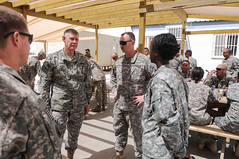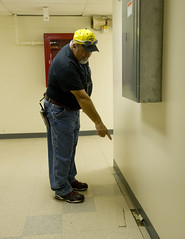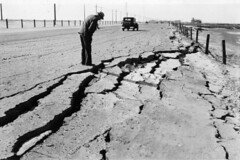| ||||||||
| ||||||||
| ||||||||
| ||||||||
| ||||||||
| ||||||||
Latest News
Tuesday, November 19, 2013
Good Ideas for Seniors -- Get Ready
Saturday, September 14, 2013
Get Ready Teachers
 Class is in session, the day is moving forward
uneventfully…then disaster strikes! Students are screaming, alarms are
ringing and it seems as if you’re surrounded by circumstances totally out of
your control. But wait a minute…take stock of
the situation and act intelligently and decisively. Here are some important
guidelines:
Class is in session, the day is moving forward
uneventfully…then disaster strikes! Students are screaming, alarms are
ringing and it seems as if you’re surrounded by circumstances totally out of
your control. But wait a minute…take stock of
the situation and act intelligently and decisively. Here are some important
guidelines:- In the event of an earthquake, teachers should give “drop, cover and hold” instructions.
- Evacuate the building in case of fire or immediately after an earthquake has occurred.
- Hold students in an assigned yard area, take a roll call and wait for further instructions. Report if anyone is missing.
- If telephones are working, call 9-1-1 for emergency assistance.
- Set up and coordinate your first aid center
- In the event of a random shooting, try to lead students to the nearest exit. If that is not possible, lock your classroom door and tell students to duck down under their desks and remain quiet.
- Once the disaster is over, dismiss students to go home only with a parent or other authorized adult.
- Do not re-enter any of the school buildings until the area is pronounced safe.
Saturday, August 24, 2013
ASPCA Has Pet Safety Pack
 For those of you who are excited about the groundbreaking of the east side dog park in El Dorado Regional Park, it is important to remember that we need to get prepared in the event of the next earthquake
For those of you who are excited about the groundbreaking of the east side dog park in El Dorado Regional Park, it is important to remember that we need to get prepared in the event of the next earthquakeASPCA has a Pet Safety Pack (https://www.aspca.org/form/free-pet-safety-pack?ms=wb_rig_petcaresection-generalsmall-201307&initialms=wb_rig_petcaresection-generalsmall-201307) that you should go on line and get. It includes stickers for your window to let first responders know there is a pet inside your home. The safety pack also includes an ASPCA Animal Poison Control Center magnet.
ASPCA has a number of great suggestions of how to get prepared. Check out their special website on this issue: http://www.aspca.org/pet-care/disaster-preparedness
The Red Cross also has a printable check list for pet owners. Check here for the list: http://www.redcross.org/prepare/disaster/pet-safety
FEMA has produced an excellent brochure that you can download by clicking: http://www.ready.gov/sites/default/files/documents/files/pets_brochure.pdf
Get prepared Long Beach!
Friday, August 16, 2013
Get Ready Business
 |
| English: Pass Christian, Miss., April 6, 2006 - Disaster preparedness publications in several languages are available through the FEMA Mitigation Division to show Gulf Coast residents how to minimize damage from hurricanes and other disasters. FEMA Mitigation reaches out to all population groups to encourage pre-disaster planning. George Armstrong/FEMA (Photo credit: Wikipedia) |
Preparedness Planning for Your Business
Businesses can do much to prepare for the impact of the many hazards they face in today’s world including natural hazards like floods, hurricanes, tornadoes, earthquakes and widespread serious illness such as the H1N1 flu viruspandemic. Human-caused hazards include accidents, acts of violence by people and acts of terrorism. Examples of technology-related hazards are the failure or malfunction of systems, equipment or software.
Ready Business will assist businesses in developing a preparedness program by providing tools to create a plan that addresses the impact of many hazards. This website and its tools utilize an “all hazards approach” and follows the program elements within National Fire Protection Association 1600, Standard on Disaster/Emergency Management and Business Continuity Programs. NFPA 1600 is an American National Standard and has been adopted by the U.S. Department of Homeland Security.
The five steps in developing a preparedness program are:
- Program Management
- Organize, develop and administer your preparedness program
- Identify regulations that establish minimum requirements for your program
- Planning
- Gather information about hazards and assess risks
- Conduct a business impact analysis (BIA)
- Examine ways to prevent hazards and reduce risks
- Implementation
Write a preparedness plan addressing:- Resource management
- Emergency response
- Crisis communications
- Business continuity
- Information technology
- Employee assistance
- Incident management
- Training
- Testing and Exercises
- Test and evaluate your plan
- Define different types of exercises
- Learn how to conduct exercises
- Use exercise results to evaluate the effectiveness of the plan
- Program Improvement
- Identify when the preparedness program needs to be reviewed
- Discover methods to evaluate the preparedness program
- Utilize the review to make necessary changes and plan improvements
Related articles
- Discover Your Disaster Recovery Preparedness (windowsitpro.com)
- SBA Free Webinar: How to Get Started on Business Continuity Plan (hispanicbusiness.com)
Friday, August 9, 2013
Smartphone App | FEMA.gov
The White House just sent information on a new app for smartphones from FEMA. Check it out.
Smartphone App | FEMA.gov
Smartphone App | FEMA.gov
Wednesday, July 31, 2013
Pledge to Prepare
 |
| 20120325-A-CY398-006 (Photo credit: 29th CAB - Public Affairs) |
http://community.fema.gov/connect.ti/system/register?nextURL=%2Fconnect.ti%2FREADYNPM%2FrequestJoinGroup%3FSHOWREG%3D%26amp%3BCONFIRM%3DN%26amp%3BDONEM
Related articles
Tuesday, July 9, 2013
If a disaster strikes...how to evacuate
| ||||||||
| ||||||||
| ||||||||
Related articles
Monday, June 17, 2013
New research challenges assumptions that the central part of the San Andreas fault would act as a barrier, preventing a big quake from traveling between the northern and southern parts of the state.
A recent article points to possibility that California could be hit by a statewide earthquake. The San Andreas fault was once thought to be a barrier that would prevent a statewide quake from happening, but now researchers say that assumption may be wrong.
The article appeared in the COPE newsletter (http://cope-preparedness.org/archives/2416). COPE stands for Community Outreach Promoting Emergency Preparedness.
The major earthquakes in Japan pointed researchers to the fact that "Using a combination of laboratory measurements and computer simulations, the two scientists showed how so-called creeping segments in a fault — long thought to be benign because they slip slowly and steadily along as tectonic plates shift — might behave like locked segments, which build up stress over time and then rupture.?
Are you ready?
The article appeared in the COPE newsletter (http://cope-preparedness.org/archives/2416). COPE stands for Community Outreach Promoting Emergency Preparedness.
The major earthquakes in Japan pointed researchers to the fact that "Using a combination of laboratory measurements and computer simulations, the two scientists showed how so-called creeping segments in a fault — long thought to be benign because they slip slowly and steadily along as tectonic plates shift — might behave like locked segments, which build up stress over time and then rupture.?
Are you ready?
Monday, June 10, 2013
Do You Know About ENLA?
Emergency Network Los Angeles, Inc. (ENLA) is a network of Los Angeles County, non profit, community based organizations (CBOs) that provide assistance to individuals, families, and organizations following emergencies and disasters. ENLA works in coordination with government agencies and the private sector.
ENLA is recognized by the Los Angeles County Operational Area and the City of Los Angeles as the networking agency for community based organizations.
ENLA is the Los Angeles County VOAD (Voluntary Organizations Active in Disasters), and is recognized by Southern California VOAD and National VOAD.
ENLA is incorporated as a 501(c)(3) organization under the laws of the State of California.
OUR MISSION
ENLA’s mission is to enhance the capacity of non-profit, community, and faith-based organizations, government agencies and the private sector for preparedness, response to and recovery from disasters in Los Angeles County by facilitating cooperation, communication, coordination & collaboration.
ENLA’s mission is to enhance the capacity of non-profit, community, and faith-based organizations, government agencies and the private sector for preparedness, response to and recovery from disasters in Los Angeles County by facilitating cooperation, communication, coordination & collaboration.
OUR HISTORY
Following the 1994 Northridge Earthquake, the Mayor of Los Angeles convened a meeting of CBOs that were active in the recovery from the disaster. The combined efforts of members of this group significantly aided the earthquake recovery efforts. In December of that year that group, which had become known as ENLA, merged with the Los Angeles County VOAD (Volunteer Organizations Active in Disasters) and the Los Angeles Access Network to bring all CBO disaster work in Los Angeles County under one umbrella. In 1997, both Los Angeles County and the City of Los Angeles designated ENLA as their primary point of contact with community based organizations for disaster preparedness and recovery efforts.
Following the 1994 Northridge Earthquake, the Mayor of Los Angeles convened a meeting of CBOs that were active in the recovery from the disaster. The combined efforts of members of this group significantly aided the earthquake recovery efforts. In December of that year that group, which had become known as ENLA, merged with the Los Angeles County VOAD (Volunteer Organizations Active in Disasters) and the Los Angeles Access Network to bring all CBO disaster work in Los Angeles County under one umbrella. In 1997, both Los Angeles County and the City of Los Angeles designated ENLA as their primary point of contact with community based organizations for disaster preparedness and recovery efforts.
Related articles
Labels:
city of long beach,
councilwoman gerrie schipske,
earthquake preparedness,
ENLA,
ready long beach
Friday, May 10, 2013
Earthquake Fact
 |
| English: This map, created by the Regional Plan Association, illustrates the Southern California megaregion (Photo credit: Wikipedia) |
Each year the southern California area has about 10,000 earthquakes. Most of them are so small that they are not felt. Only several hundred are greater than magnitude 3.0, and only about 15-20 are greater than magnitude 4.0. If there is a large earthquake, however, the aftershock sequence will produce many more earthquakes of all magnitudes for many months.
Related articles
Monday, April 1, 2013
Fire Risks for Older Adults
 |
| Fire alarm notification appliance (Photo credit: Wikipedia) |
Older adults—those over 65 years of age—represent one of the highest fire risk groups
in the United States, in large part because they are the fastest growing segment of the U.S. population.
Of course, many older adults may also fall into the other three groups since the elderly suffer
some or all of these impairments to a much greater degree than do the general population.
People who are deaf or have hearing impairments, those who are blind or have vision impairments,
and those with mobility impairments may face unique challenges in an emergency. Their
ability to detect a fire or escape its effects may be hindered by their impairments. As a result,
people with these impairments are at a greater risk of death or injury due to fire.
As might be expected, many of the fire safety issues are of concern for all four groups.
This commonality is reflected in the reports, particularly in the fire safety tips, most of which apply
to all the groups. These safety tips are presented in an appendix at the end of each report, organized
in three sections: before the fire, during the fire, and fire prevention.
The tips that are common to all four groups are summarized here:
Before the Fire
· Identify the nearest fire exit
· Install smoke alarms
· Live near an exit
· Plan and practice escape plans
· Involve the fire department
During the Fire
· Get out and stay out
· Test doors before opening them
· Stay low and go
· What to do if you are trapped
· Stop, drop, and roll
Fire Prevention
· Cooking
· Electrical safety
· Smoking
· Space heaters
· Heating
· Fireplaces
See the following for a complete report on this important issue.
Related articles
Saturday, March 23, 2013
Wednesday, March 13, 2013
Storage Areas for Earthquake Supplies
FEMA through Ready.gov has the following recommendations of where to store your earthquake supplies:
(http://www.ready.gov/kit-storage-locations)
(http://www.ready.gov/kit-storage-locations)
Labels:
councilwoman gerrie schipske
Monday, March 11, 2013
80th Anniversary of Long Beach Earthquake -- 33 quakes Hit on Saturday
Someone sent me a text following our very successful Get Ready Long Beach workshop this past Saturday remarking that "you are good. You have an earthquake preparedness workshop and then there was an earthquake in Southern California. How'd you do it?"
That is true. Following our workshop almost 33 quakes were registered in Southern California by the US Geological Service. But this is not uncommon in Southern California which is why we need to get prepared. It isn't a matter of if but when.
Below is an excerpt from USGS about the Long Beach earthquake which hit on March 10, 1933 at 5:54 pm:
March
10, 1933 at 5:55pm a 6.3 magnitude earthquake struck on the
Newport-Inglewood fault. Shocks similar in magnitude and intensity to this
event have occurred in this area in the past - notably July 28, 1769; December
8, 1812; and July 11, 1855.
This earthquake caused serious damage to weak masonry structures
on land fill from Los Angeles south to Laguna Beach. Property damage was
estimated at $40 million, and 115 people were killed.
Severe property damage occurred at Compton, Long Beach, and
other towns in the area. Most of the spectacular damage was due to land fill,
or deep water-soaked alluvium or sand, and to badly designed buildings. Minor
disturbances of ground water, secondary cracks in the ground, and slight earth
slumps occurred, but surface faulting was not observed. Along the shore between
Long Beach and Newport Beach, the settling or lateral movement of road fills
across marshy land caused much damage to the concrete highway surfaces and to
approaches to highway bridges.
At Compton, almost every building in a three-block radius on
unconsolidated material and land fill was destroyed. At Long Beach, buildings
collapsed, houses were pushed from foundations, walls were knocked down, and
tanks and chimneys fell through roofs. Damage to school buildings, which were
among the structures most commonly and severely damaged by this earthquake, led
to the State Legislature passing the Field Act, which now regulates
building-construction practices in California.
The earthquake was felt almost everywhere in the 10 southern
counties of California and at some points farther to the northwest and north in
the Coast Range, the San Joaquin Valley, the Sierra Nevada, and the Owens
Valley. It also was reported in northern Baja California. A sharp foreshock
occurred near Huntington Beach on March 9, and many aftershocks occurred
through March 16. For several years, minor aftershocks continued to occur, most
often centering near the two ends of the disturbed segment of the
Newport-Inglewood fault.
Related articles
Saturday, February 23, 2013
Earthquake Hits San Diego -- Are You Ready Long Beach?
 |
| Earthquake (Photo credit: NASA Goddard Space Flight Center) |
Click on the link to read about the latest earthquake nearby. Smaller quakes have hit the area earlier.
Folks, important that Long Beach get ready for an earthquake -- and not just focusing on replacing a City Hall. We need to make certain we have equipment and emergency personnel that can respond if we are hit by a large earthquake.
Related articles
Saturday, February 16, 2013
KCET Host Val Zavala Joins Councilwoman Gerrie Schipske for Ready Long Beach
 |
| Val Zavala |
KCET Host Val Zavala joins Councilwoman Gerrie Schipske on
March 9th, 9am until 2 pm at the Ready Long Beach public forum on how to get
ready for the next big earthquake. Zavala is featured on the KCET Special Bracing
for a Quake and appears on the popular public affairs program SoCal Connected.
 |
| 1933 Long Beach Earthquake |
Ready Long Beach will be held at the El Dorado Community
Center, 2800 N. Studebaker.
 |
| Clock in downtown Long Beach which stopped at exact time of earthquake in 1933. |
Councilwoman Schipske will present a historic look at the
1933 Long Beach earthquake followed by experts from USGS, FEMA, CAEMA, Long
Beach Fire Department, CERT and American Red Cross who will discuss current
information on how to prepare to survive a major earthquake. The event is open
to the public. Lunch will be provided and then residents are encouraged to work
with representatives of the local American Red Cross in outlining how they can
prepare their own neighborhoods.
Ready Long Beach is a project of 5th District Councilwoman
Gerrie Schipske.
Tuesday, January 29, 2013
Earthquake Detection Needed Says Experts
 |
| Cracked highway near Long Beach, 1933 (Photo credit: California Watch) |
In a Los Angeles Times article, it was pointed out that the alert could give other communities precious seconds of notice that would allow metro and trains to be stopped to prevent derailment.
For more information on the proposed system click here.
Related articles
Subscribe to:
Posts (Atom)







































